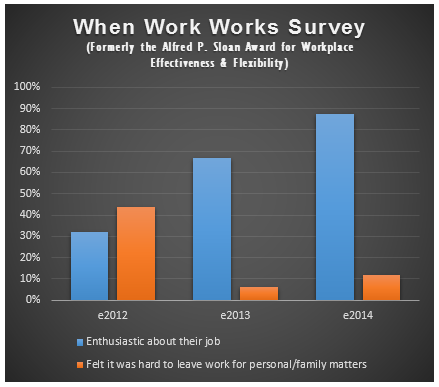In yesterday’s Advisor, Megan Lee, SPHR, SHRM-SCP, told how her company organized flextime when every employee had to be physically on-site every day. Today, more about her program, including the extraordinary results she achieved.
 |
Lee, who is the director of human resources at Architecture Technology Corporation (ATC), offered her tips at SHRM’s Talent Management Conference and Exhibition, held recently in San Diego.
[Go here for Steps 1 and 2]
3. Policy/Handbook Changes
The ATC evaluated their current procedures/policies:
- Of those that did not allow flextime, which ones were negotiable?
- Is there truly a business need for these nonflexible policies?
- What could be added to increase flexibility?
The ATC made the following changes:
- Of those that did not allow flextime, which ones were negotiable?
- Is there truly a business need for these nonflexible policies?
- What could be added to increase flexibility?
The ATC made the following changes:
- Added paid time off instead of traditional sick/vacation
- Added extended leave bank (ELB)
- Each employee gets 40 hours in bank
- Has no cash value
- Used with FMLA events
- Added paid paternity leave
- Added bereavement pay
- Employees get 3 consecutive days off in the event of an immediate family member
- Employees get 1 day off in the event of a secondary family member
- Added commitment to continuing education. We encourage employees to attend classes and conferences that are relative to their jobs. We pay for:
- PMP certification and recertification
- Enterprise Architecture certification and recertification
- Six Sigma Training
- SHRM-CP and SHRM-SCP Continuing Education
- Added work flex policy
- No more mandatory 8 hours per day.
- All of our employees are hourly.
- 40-in-5 rule (must work 40 hours and log some hours all 5 days).
- Employees set their own hours.
- Teams work around employees’ hours.
- Employees establish with supervisors a set arrival time, (if later than that, call—it’s a safety thing).
- Average manager works 45 hours.
- Most of our managers front-load their hours.
Recruiting is a challenge for 2015. Learn what’s happening in the real world with our new research report, Recruiting Best Practices: Finding and Attracting Talent in 2015’s Challenging Business Climate. Learn More.
4. Implementation
Lee offers the following tips for the implementation phase:
- Survey employees; what do they really want?
- Understand what motivates management (you need management buy-in).
- Why are you making this change?
- Focus on positives, i.e., cost savings, more engagement.
- Find a champion; major changes need a champion.
- Be ready to articulate anticipated pros/cons of change.
- Make a plan.
- How will you implement?
- Timeline.
- What policies need to be changed/added?
- What are the anticipated outcomes?
- Start small; be patient. Perhaps pilot with one team or one division.
- Have clearly defined expectations; insist on measurable outcomes.
- Take ownership at every step.
- Be flexible.
- Rome was not built in a day.
ATC Work-Flex Outcomes (!)
Lee shows very positive results for the ATC program. Enthusiasm is dramatically increased, and the feeling that it was hard to leave work for personal or family matters dropped substantially.

Additional indicators of the positive effect of flextime:
- 93% would recommend the ATC as an employer to a friend/colleague.
- 5% voluntary turnover rate.
- Revenues have increased.
In summary, says Lee, key takeaways are:
- Have a plan.
- Anticipate management’s objections.
- Know what your nonnegotiables are.
- Know when to stop pushing.
- Rome wasn’t built in a day.
- What is your work flextime mission?
Flex time can be a good perk to help in your recruiting and retention efforts. Curious to know more about what else is going on with recruiting in the real world? We can help. Six times a year, the HR Daily Advisor Research Team conducts detailed research into contemporary HR challenges to highlight best practices and common policies and procedures. The topic for this report is one of the most pressing for human resources—recruiting.
Recruiting is changing at a rapid pace. Some organizations are abandoning traditional methods for social media; some think software can do a better job than people. See the results of our national survey as well as demographic breakdowns for each question.
Available in both print and downloadable PDF versions.
Recruiting strategies? Onboarding practices? What’s working in retention? It’s all in this report: Recruiting Best Practices: Finding and Attracting Talent in 2015’s Challenging Business Climate. Click Here.
Among the features of this new product:
- Results from our national survey on recruiting best practices
- Further results of a supplemental survey on recruitment metrics and costs
- National data from the main survey broken down by key demographics
- Summaries and highlights
- And much more!
Don’t be left in the dark! With the information in this report, you will get a feel for what’s working out there—and maybe learn a little about what your competitors might be up to.
